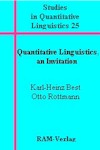Studies in Quantitative Linguistics 25, “ Quantitative Linguistics, an Invitation“
Editorial Bord of Studies in Quantitative Linguistics
PREFACE
The present book is a strongly extended translation of the German original „Quantitative Linguistik. Eine Annäherung”, 3rd edition. (Göttingen: Peust & Gutschmidt Verlag 2006). It is written for beginners in a rather “non-mathematical” language and contains many computations showing the procedures which should be followed by a researcher who begins to work with a language. It aims at showing some law-candidates concerning length, diversification, evolution, borrowings, ranking, mutual relations, first steps in synergetics, etc. A hypothesis can become law only if it is derived from a theory and corroborated on as many texts and languages as possible. An introduction to the history of quantitative linguistics shows that there is a very old tradition beginning about 2500 years ago.
Writing an introduction one never knows whether the contents and the way of presentation will attract or discourage the young readers. On the other hand, there are a small number of introductions which can show the reader some backgrounds of quantitative linguistics. Usually, the authors fulfill the books by mathematics, deriving of models, statistical tests, computing some probabilities etc. and the beginner does not know what to do. The present book shows how to define, how to count, how to fit a function or a distribution, how to evaluate it and how to present it in a publication. The rich bibliography attached to the book helps the reader to find ready evaluations, descriptions of the problem, the way of attaching the results to an existing theory, etc. The authors refer to many works written by their students and published in form of articles or dissertations.
The main motive of the book is: Begin and do not cease! Mathematics is no misfortune, on the contrary, it is a means to exactly express our findings and attach them to other ones. Even simple quantitative data collections are better than speaking about something in a non-formal language without any trials for corroboration.
The editorial board of this series recommends both to beginners and to advanced scholars to imitate the results using as many languages as possible in order to corroborate the existing results.
Gabriel Altmann

